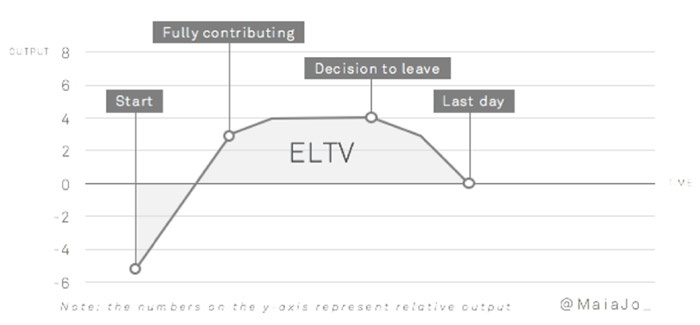
HR is a pro-active practice, and things can quickly go downhill when it is not managed properly. Of course, measuring the ROI on HR spend isn’t as simple as it may be for other departments like sales or marketing, but it is important to measure the impact your HR investments have on the bottom line.
We know for example, that high employee churn is costly, and that unproductive employees impact the bottom line, but did you know that diverse companies are more profitable than their nondiverse peers? Any good HR team is measured not just on effective recruitment, but also on retention rate, productivity and diversity. It makes sense then that increasing the effectiveness of these three areas will help HR teams increase their return on investment.
Increase ROI on HR spend by optimizing your people processes
Recruiting expert Maria Josebachvili believes that you can measure the ROI of HR and culture using something called the ELTV or “employee lifetime value”. As illustrated in the chart below, the ELTV shows how a typical employee contributes to an organization’s bottom line during their tenure.

There are at least three important points where good HR processes can impact the bottom line by increasing employee retention and productivity.
Process 1: Effective employee integration boosts productivity
When a new hire starts at your company, they tend to take more than they give. They don’t know where anything is or who anyone is. An efficient onboarding process can accelerate their ramp-up time, enabling them to become productive faster.
But an efficient onboarding process isn’t enough to deliver outstanding ROI. New hires need to be properly integrated into the DNA of your organization so that they can deliver their best work. An employee integration program is a long-term process designed to help new hires get to know key stakeholders, feel confident in their roles, and find mentors – all of which have a huge impact on retention rates.
To learn more about the importance of an effective employee integration program, read this post: How many great people are you losing due to poor employee integration?
Process 2: Career planning and development boosts employee value
Motivation is closely tied to career development. People are more willing to work hard when they know where they’re going and feel supported on the journey. And when people are given the opportunity to grow and reach their full potential, they add a lot more value to the team and organization they’re part of. According to software purchasing review site BetterBuys, companies that offer professional development enjoy a 34% higher retention rate than those that don’t.
Defined career maps, effective performance reviews, careful management of top performers, and internal gig opportunities will help you hang on to your best people and develop them so that they can add even more value to the business.
Process 3: Cultivate an outstanding culture to reduce retention
Improving company culture builds loyalty and reduces retention. Top performers in particular, value open, flexible cultures where people are given autonomy.
Here are a few ways you can improve company culture to extend the tenure of employees and reduce attrition rates:
- Keep everyone going in the right direction by sharing the company’s vision – and ensuring employee KPIs are aligned to it.
- Show them you care by treating them as individuals. Tailored retention and wellness programs and a bit of fun are all part of what makes a great workplace.
- Encourage autonomy. High performers value the freedom to do things their own way. For this to work, you need to ensure that the people your company hires are experienced and equipped to work independently. Managers need to be very clear about expectations and limitations.
- Recognize and reward. When people work hard and push themselves, they deserve to be recognized for positive results. A company that punishes failure without recognizing success will stymie innovation and risk taking, and leave employees feeling undervalued and frustrated.
You can’t manage what you can’t measure
Is your new employee integration program working? Are attrition rates decreasing? Are there any patterns that point to problems in a particular location or department? How are your minority employees faring?
If you can’t make informed decision if you can’t measure the impact of HR initiatives. Any you can’t expect increased investment if you can’t show ROI.
Technology that creates transparency
vi by Aderant’s integration, retention, diversity, and performance management tools are designed to give leaders this insight. They’re lightweight solutions that bolt onto existing people management platforms to provide powerful reporting and insights, as well as automation of timeline-based initiatives like integration and onboarding strategies.
To learn more, watch the video below or get started with a quick demo.